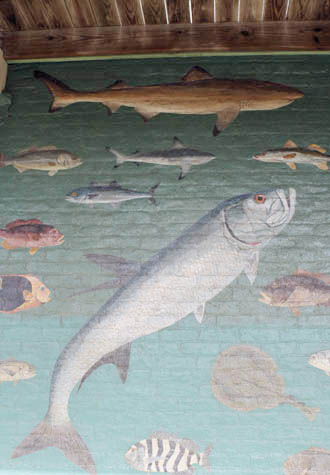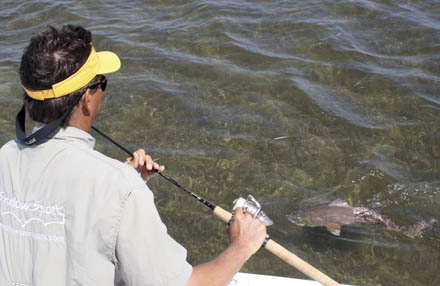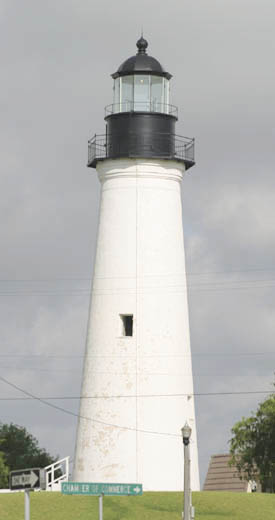
The Saltwater Magazine for Gulf Coast Fishing!
FISHING FORECASTS
| FISHING CALENDARS | ARTICLES | ADVERTISE
| SUBSCRIBE
Search Gulf Coast Fisherman's
Web Site
Past articles, specific
places or fish, etc.

Port Isabel
A Gem in Deep South Texas
by Capt. Danno Wise
| CURRENT
MOON lunar phases |

One of the oldest towns on the Gulf Coast, Port Isabel, was once home to the largest shrimp fleet in Texas. Although the commercial fishery has begun to fade, recreational fishing is on the upswing in this small South Texas town. As the mainland launching point to the Lower Laguna Madre, the same waterfront community that once saw pirates and Civil War soldiers land on its shores, now welcomes thousands of light tackle fishermen in search of speckled trout, redfish, snook and tarpon.
Thanks to its subtropical climate (it is located just a dozen miles above the Texas/Mexico border) Port Isabel offers fishermen year-round angling opportunities. Additionally, the warm climate and shallow, clear waters of the Lower Laguna Madre offer a variety of species and habitat not found elsewhere in the United States, with the exception of South Florida.
 Without a doubt, the most popular activity
for fishermen heading to Port Isabel is sight casting to redfish on the
shallow flats. This, too, is an activity that can be enjoyed all 12 months
of the year. Depending on the season, redfish will transition from sand
flats to grass and mud flats. However, with the exception of a rare hard
cold spell, there are always redfish to be found in less than two feet of
water, where they are easily targeted by anglers with both conventional
and fly fishing gear.
Without a doubt, the most popular activity
for fishermen heading to Port Isabel is sight casting to redfish on the
shallow flats. This, too, is an activity that can be enjoyed all 12 months
of the year. Depending on the season, redfish will transition from sand
flats to grass and mud flats. However, with the exception of a rare hard
cold spell, there are always redfish to be found in less than two feet of
water, where they are easily targeted by anglers with both conventional
and fly fishing gear.
Also lurking on these shallow flats are speckled trout. The Lower Laguna Madre has long produced speckled trout of legendary proportions. In fact, the current state record fish was taken within sight of Port Isabel's historic lighthouse. Fish crowding 30 inches are not out of the question any time an angler wets a line in the Lower Laguna.
Tarpon are another popular target in the Lower Laguna Madre. Although there is a small resident population of juvenile tarpon that are available year around, the vast majority of silver kings migrate through the area between April and October. Tarpon are taken sporadically from the bay, but can be consistently targeted in the Brazos Santiago Pass, which connects the shallow waters of the Lower Laguna to the open Gulf of Mexico, and is a short 15 minute boat ride from the shores of Port Isabel. During the summer months, the Pass also holds good numbers of both king and Spanish mackerel.
In addition to these "glamour" species, fishermen can busy themselves catching flounder, black drum, sheepshead, gag grouper, mangrove snapper, and more. Mangrove snapper, in particular, are a popular "nongame" species in the Lower Laguna. Found near structure, such as causeways and jetties, these hard fighting fish taste every bit as good as their offshore cousin, the red snapper, and are accessible to boating and shore bound anglers alike.
Beyond angling, Port Isabel and the surrounding area offers a slate full
of activities. From restaurants to historic attractions to nature watching
and outdoor  recreation, there are plenty
of ways for a family to round out a vacation.
recreation, there are plenty
of ways for a family to round out a vacation.
The iconic attraction in Port Isabel is the Point Isabel Lighthouse. Originally built in 1852 to help guide ships from the Gulf of Mexico through the Brazos Santiago Pass to the shores of Port Isabel, the Point Isabel Light went into service in 1853. Although the structure itself is only 57 feet, it sits atop a 25-foot high bluff, giving the light a total height of over 80 feet.
The lighthouse was activated, deactivated and reactivated several times during its service period, including multiple times during the Civil War as it switched hands between the Confederacy and the Union troops in South Texas. However, in 1905, it was deactivated for good, although the government maintained the property for some two decades longer. After being bought and sold numerous times, the Point Isabel Lighthouse finally became the smallest state park in Texas in 1952.
Adjacent to the Lighthouse are the Museums of Port Isabel. The two museums that, along with the lighthouse, comprise the Museums of Port Isabel are the Historic Port Isabel Museum and the Treasures of the Gulf Museum. The Historic Port Isabel Museum showcases the area's history from Native American times to modern day and is housed in the Champion Building, which was originally built as a dry goods store in 1899. A unique feature of the Champion Building is its "fish mural facade" which has been fully restored. The Treasures of the Gulf Museum features the three Spanish shipwrecks of 1554, which occurred in the nearshore waters of the Gulf of Mexico. Relics from these shipwrecks and other Gulf "treasures" are on display at the Treasures of the Gulf Museum.
The lighthouse is encircled by a group of refurbished old buildings housing a variety of shops and restaurants. The SPI Nature Center is also located in this old town square. And, docking behind Pirate's Landing, which is one of the restaurants surrounding the lighthouse, is the Black Dragon, a replica pirate ship that sails daily on the Lower Laguna with a crew full of "pirates" that perform for visitors during the tour. Other birding, dolphin watch and sight-seeing tours are available from a variety of locations throughout Port Isabel, as well.
Just across the Queen Isabella Memorial Bridge lie the beaches, restaurants, shops and nightclubs of South Padre Island. Other attractions on South Padre include the World Birding Center and Sea Turtle, Inc. Anglers can also take advantage of surf and jetty fishing opportunities throughout the year. During the warm weather months, the surf is full of snook, tarpon, trout, Spanish mackerel, and redfish. In the cooler months, pompano, black drum, redfish, sand trout and whiting are the main targets.
Located a few miles south of Port Isabel on Highway 48 are a pair of natural wetlands - San Martin Lake and the Bahia Grande. Each of these natural wetlands now draw water via a canal connected to the Brownsville Ship Channel. The Bahia Grande was actually dry for more than five decades following the construction of the BSC. However, in 2005, this 10,000 acre wetland was reflooded, making it the largest wetlands reclamation project in North America. Today, both bodies of water provide excellent bird watching, paddling and fishing opportunities for visitors.
Those who wish to continue down Hwy 48 into Brownsville, roughly 20 miles from Port Isabel, will find a variety of shops and restaurants, as well as the widely acclaimed Gladys Port Zoo. Opened in 1971, the GPZ covers 26 acres and houses more than 1,300 acres. It has garnered national notoriety for its creative and natural exhibits.
 Between Port Isabel and Brownsville,
visitors may also want to take a few minutes to stop and tour the Palo Alto
Battlefield. The often overlooked Battle of Palo Alto, which occurred May
8, 1846, was the first battle in the US/Mexican war. Today it is designated
as a National Historic Site, is open for tours and includes a small museum
and visitor center.
Between Port Isabel and Brownsville,
visitors may also want to take a few minutes to stop and tour the Palo Alto
Battlefield. The often overlooked Battle of Palo Alto, which occurred May
8, 1846, was the first battle in the US/Mexican war. Today it is designated
as a National Historic Site, is open for tours and includes a small museum
and visitor center.
A few miles north of Port Isabel is another destination for outdoor enthusiasts - the Laguna Atascosa Wildlife Refuge. Best known for its resident population of ocelot, the Laguna Atascosa encompasses more than 45,000 acres, much of it fronting the Lower Laguna Madre. The refuge features numerous biking and driving trails, as well as birding blinds and lookout towers.
Getting to Port Isabel is relatively easy, although it does require some driving. The most convenient major airport is Valley International Airport in Harlingen, some 45 minutes away.
Whether flying in and renting a car at the airport or driving down the entire trip, anglers must pass through Harlingen via US 77 South to the State Hwy 100/South Padre Island exit. From that point, follow State Hwy 100 east for 21 miles and you'll find yourself in downtown Port Isabel, just moments away from a memorable sightseeing and angling adventure.

